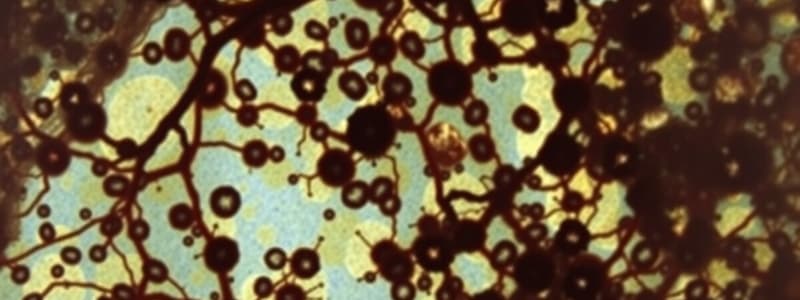Podcast
Questions and Answers
What is the primary focus of molecular cell biology?
What is the primary focus of molecular cell biology?
- The study of population dynamics in cellular communities
- The study of genetic inheritance and chromosomal behavior
- The study of cell structure and function at a molecular level (correct)
- The study of ecosystems and environmental interactions
Which of the following diseases is NOT mentioned as a major focus of molecular research?
Which of the following diseases is NOT mentioned as a major focus of molecular research?
- Diabetes (correct)
- Infectious diseases (e.g., AIDS)
- Cancer
- Cardiovascular diseases
Who is credited with the discovery of cells in 1665?
Who is credited with the discovery of cells in 1665?
- Gregor Mendel
- Louis Pasteur
- Robert Hooke (correct)
- Antonie van Leeuwenhoek
What historical advancement led to the discovery of cells?
What historical advancement led to the discovery of cells?
What term did Robert Hooke use to describe the small compartments he observed?
What term did Robert Hooke use to describe the small compartments he observed?
Which major field of study focuses on how cells communicate and respond to signals?
Which major field of study focuses on how cells communicate and respond to signals?
What aspect of cells does the study of cellular senescence pertain to?
What aspect of cells does the study of cellular senescence pertain to?
What is NOT a key area of research in molecular cell biology?
What is NOT a key area of research in molecular cell biology?
What term describes the analysis and study of genomes and post-genomic data?
What term describes the analysis and study of genomes and post-genomic data?
Which of the following is commonly studied to understand programmed cell death?
Which of the following is commonly studied to understand programmed cell death?
Flashcards are hidden until you start studying
Study Notes
Cell Structure Study Methods
- Numerous microscopic techniques are employed to study cell structures, including both light and electron microscopy.
- Light Microscopes: Brightfield, Fluorescence, Laser Scanning Confocal, Phase Contrast.
- Electron Microscopes: Transmission Electron, Scanning Electron, Scanning Tunneling, Atomic Force.
Microscope Properties
- Resolving power, not magnification, is the critical feature of microscopes for distinguishing close objects.
- Common units of measurement in microscopy: 1 meter = 100 cm = 1000 mm = 10^6 µm = 10^9 nm.
Fluorescence Microscopy
- Fluorescence microscopy relies on specimens absorbing light at one wavelength and emitting light at a longer wavelength.
- Common fluorescent dyes include fluorescein (green light emission) and tetramethylrhodamine (red light emission).
Component Study Methods
- Flow Cytometry is utilized for analyzing and sorting cell populations.
- Cell component isolation techniques incorporate centrifugation.
Cell Engineering
- Techniques include cell fusion and molecular entry mechanisms into cells, such as attachment, uncoating, release, transcription, replication, assembly, and translation.
Overview of Molecular Cell Biology
- Molecular Cell Biology examines cell structure and function through a molecular lens, crucial for advancements in medicine, agriculture, and biotechnology.
Key Research Areas
- Current research concentrates on three major diseases: cancer, cardiovascular diseases, and infectious diseases (e.g., AIDS, hepatitis).
- Significant research fields include cell cycle control, apoptosis, cellular senescence, signal transduction, and DNA damage/repair.
History of Cell Theory
- Cell discovery initiated with microscopy; Robert Hooke identified and named cells in 1665, observing honeycomb-like structures and coining the term "cellulae."
Important Research Fields
- Predominant research areas involve signal transduction, cell apoptosis, and genome/post-genomic analysis, emphasizing their roles in understanding cellular functions and diseases.
Studying That Suits You
Use AI to generate personalized quizzes and flashcards to suit your learning preferences.



